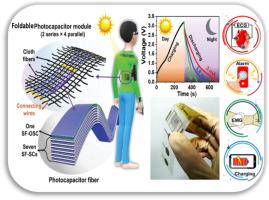Foldable Photo-Charged Supercapacitors: Materials, Technology Challenges, and Applicability
IF 5.6
3区 材料科学
Q1 ELECTROCHEMISTRY
引用次数: 0
Abstract
Foldable photo-charged supercapacitors (FPCs) represent a breakthrough in flexible energy storage, combining energy harvesting and storage within a single device. These supercapacitors leverage electrostatic and electrochemical mechanisms to achieve superior performance, making them ideal for wearable and portable electronics. Their ability to instantaneously harvest and store energy from light enhances their applicability in intelligent devices, healthcare monitoring, and motion detection.This state of art displays the different types of the employed advanced electrode materials, including carbon fibers, conducting polymers, and hybrid composite structures. Additionally, the recent techniques for integration with photovoltaic technologies will be sufficiently discussed. These advancements enable self-powered electronic devices with high energy densities and extended operational lifetimes. The article also demonstrates the possible manufacturing techniques to facilitate scalable production of FPCs with flexible and lightweight architectures. Moreover, the technological challenges such as material compatibility, electrolyte leakage, and performance mismatches between photovoltaic and storage components are significantly addressed to ensure commercial viability.Novel packaging solutions are crucial for ensuring durability, mechanical flexibility, and biocompatibility for wearable applications. The development of self-healing materials and improved solid-state electrolytes will further enhance the resilience and safety of these devices.FPCs are promising for various applications, including health monitoring, electronic textiles, and smart fabrics, as discussed in this article. Future research should focus on optimizing energy conversion and storage efficiency, integrating multi-functional energy harvesting technologies, and developing sustainable manufacturing processes. As FPC technology advances, its impact on smart electronics, IoT systems, and sustainable energy solutions will continue to expand, paving the way for innovative and energy-efficient applications.

可折叠光电超级电容器:材料、技术挑战和适用性
可折叠光电超级电容器(FPCs)代表了柔性能量存储的突破,将能量收集和存储结合在单个设备中。这些超级电容器利用静电和电化学机制来实现卓越的性能,使其成为可穿戴和便携式电子产品的理想选择。它们从光中即时收集和存储能量的能力增强了它们在智能设备、医疗保健监控和运动检测中的适用性。这项技术展示了不同类型的先进电极材料,包括碳纤维、导电聚合物和混合复合材料结构。此外,将充分讨论与光电技术相结合的最新技术。这些进步使自供电电子设备具有高能量密度和延长的使用寿命。本文还演示了可能的制造技术,以促进灵活和轻量级架构的fpc的可扩展生产。此外,光伏和储能组件之间的材料兼容性、电解质泄漏和性能不匹配等技术挑战也得到了显著解决,以确保商业可行性。新颖的包装解决方案对于确保可穿戴应用的耐用性、机械灵活性和生物相容性至关重要。自修复材料和改进的固态电解质的发展将进一步提高这些设备的弹性和安全性。fpc有望用于各种应用,包括健康监测、电子纺织品和智能织物,如本文所述。未来的研究应集中在优化能量转换和储存效率、集成多功能能量收集技术、开发可持续制造工艺等方面。随着FPC技术的进步,其对智能电子产品、物联网系统和可持续能源解决方案的影响将继续扩大,为创新和节能应用铺平道路。
本文章由计算机程序翻译,如有差异,请以英文原文为准。
求助全文
约1分钟内获得全文
求助全文
来源期刊

Electrochimica Acta
工程技术-电化学
CiteScore
11.30
自引率
6.10%
发文量
1634
审稿时长
41 days
期刊介绍:
Electrochimica Acta is an international journal. It is intended for the publication of both original work and reviews in the field of electrochemistry. Electrochemistry should be interpreted to mean any of the research fields covered by the Divisions of the International Society of Electrochemistry listed below, as well as emerging scientific domains covered by ISE New Topics Committee.
 求助内容:
求助内容: 应助结果提醒方式:
应助结果提醒方式:


